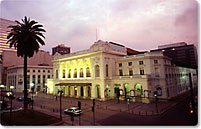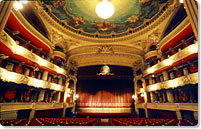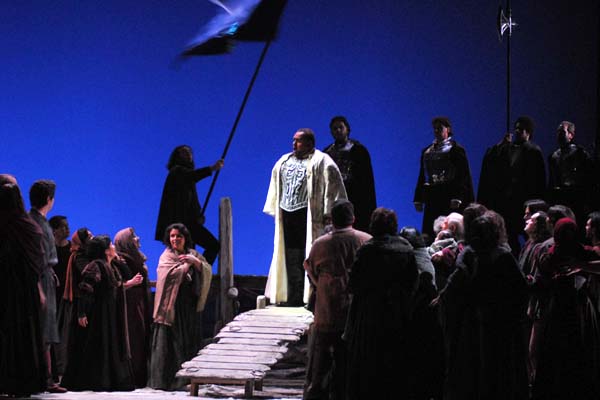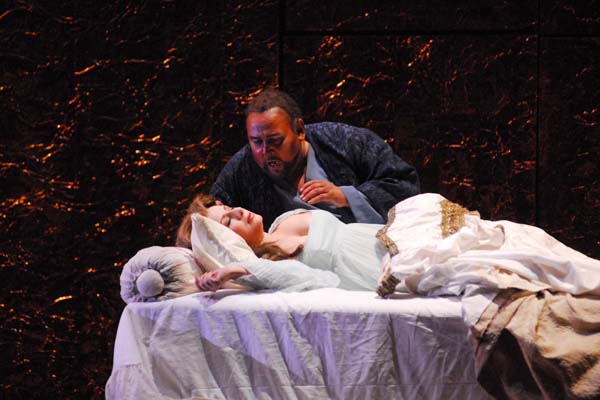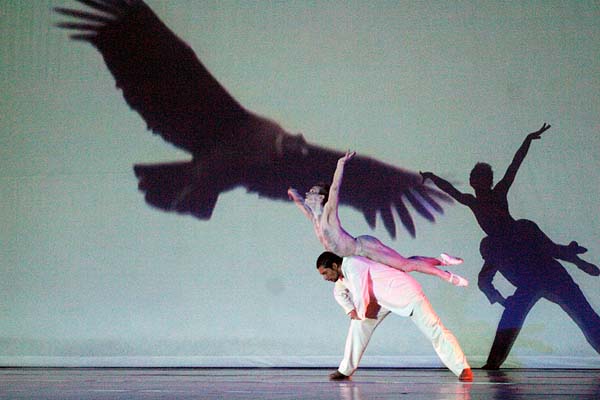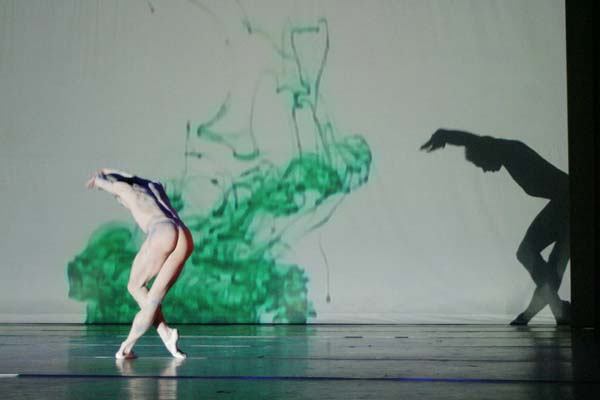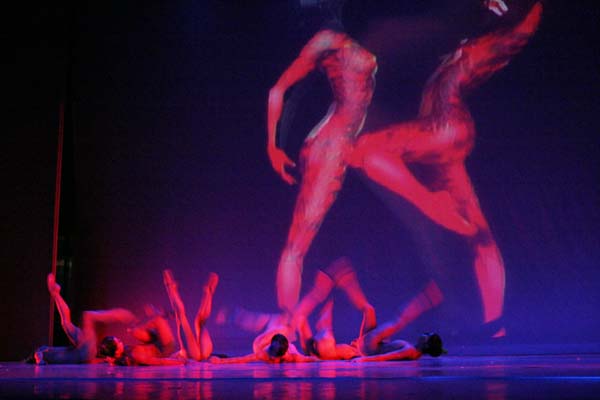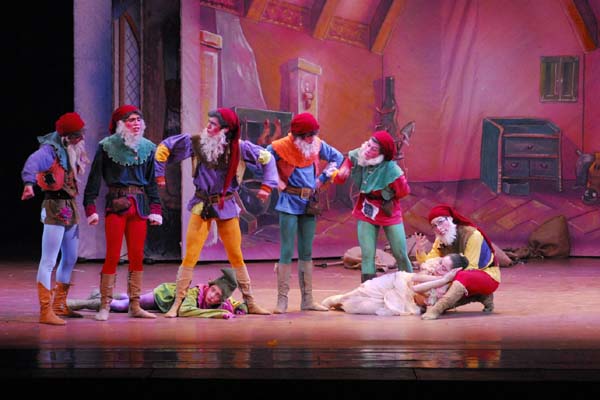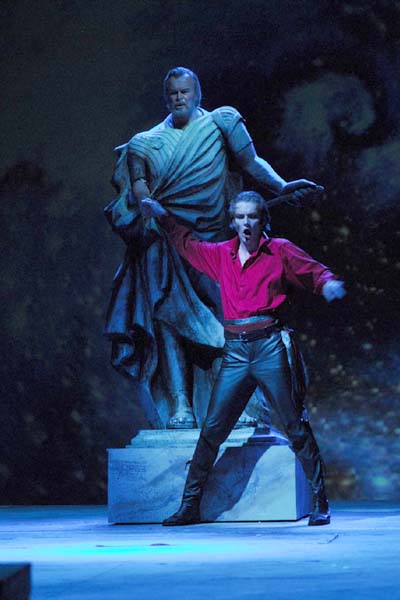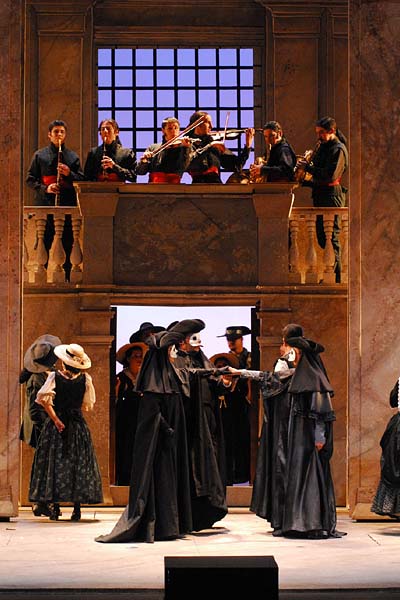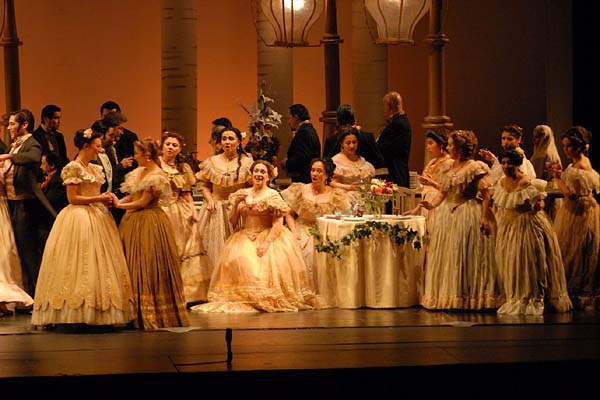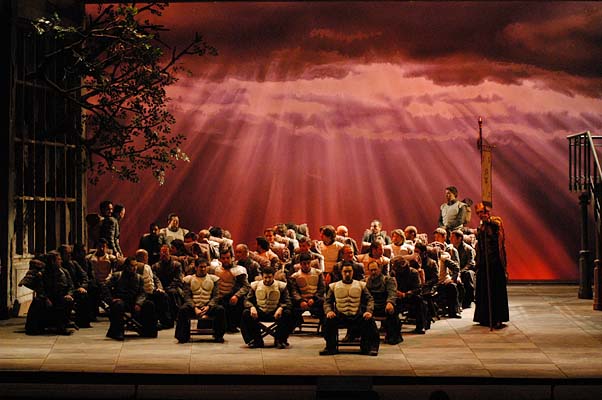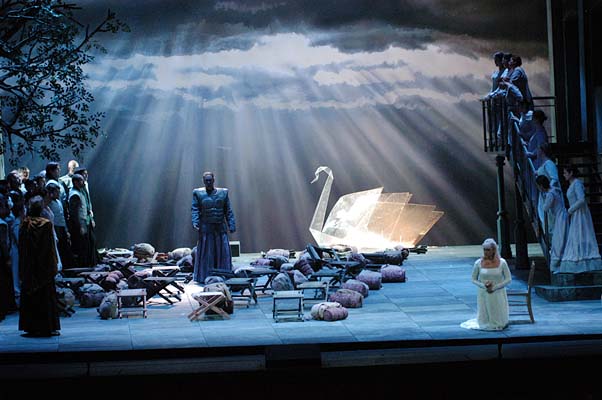Main activities of the Municipal Theater
- Would you give us a brief explanation of the history and present status of the Santiago Opera Theater?
- Our Opera Theater is one of the oldest in South America. Construction began in 1853 and the Opera Theater opened on September 17, 1857. So, next year will be our momentous 150th anniversary. The Teatro Solis in Montevideo, Uruguay, is one year older and it is celebrating its 150th anniversary this year. Our theater has a full season of opera, ballet and concerts and we have a permanent chorus, ballet company and orchestra as well as the necessary studios and workshop facilities to enable us to prepare all kinds of productions. The building is beautiful 1,500-seat opera theater built in the French and Italian baroque style. The interior is finished in warm reds and gold. Since it is an old opera house, it needs technically to be updated, but in the technical aspect there are some limitations because of the structure of the stage and the limited wings next to it.
- So, is your Municipal Theater basically an opera theater?
- Opera is the most popular and has a large audience, so that is what is expected of our theater most. In addition to our opera season we also have a great ballet season and a symphonic season on our year schedule. And, we have one, our own orchestra that fills all the demands of these season schedules.
- How many people are there on the theater staff, including the backstage technicians?
-
In total in our theater we have approximately 400 people working permanently.
We have a chorus of 60 people, an 82-person orchestra, and a 55-person ballet company. There is also a ballet school and if you include that staff there are altogether 65 people in the ballet. Then we have the technicians and the administrative staff. Although there is an opera season but there is no opera company as such. We have an orchestra and a chorus and every season we plan opera productions and we search for appropriate types contracts with soloists in Chile and from other countries. We have no full-time soloists. We have auditions prior to each season. And we choose strictly on the basis of the singer’s quality, without regard to age or nationality. - Are you the one that makes the choices?
- Yes, but I have a team who works closely with me. The board of directors makes the decision on every season’s budget and they give the final approval for the seasons. And, although next year will be an exception because it is an anniversary year, the annual budget doesn’t vary much.
- What kinds of people sit on the board of directors?
- They are business and culture people of influence. Some are directors of large companies. And, they are people with cultural appreciation and some of them with knowledge of music. Some of them are people I see almost as often as my own staff. The important job of the Board of Directors is to maintain the overall balance. The Chairman of the Board is the Mayor of Santiago.
- Was it the Mayor who appointed you as Artistic Director?
- Yes. I am a lawyer by profession. Then, when I was studying music in Italy, the Mayor of Santiago at that time convinced me to come back to Chile and to start working for the advancement of music there. The first things I did were to ask for an increase in budget and a re-building of the orchestra and the ballet company. It was also the time to start working in a major project that was new for Chile: the establishment of a professional chorus in the theater. We started with 30 people and then the number of singers was increased to 40, and today we have a full chorus of 60 people.
- What languages are your theater performances in?
- All our opera performances are presented in their original languages. When we did a production of Jenufa , for example, it was performed in the original Czech. A German opera is sung in German and Britten is sung in English. We have been using subtitles in our performances for 20 years now. I saw subtitles being used for the first time in Houston in 1984 and immediately after that we had a system installed in our theater in Santiago. That created a bit of an uproar at the time. People complained that subtitles weren’t necessary because the opera audience already knew the contents of the drama or the plot. But, I thought it was necessary in order to get a broader audience coming to the opera. Today, subtitles have become the norm and, contrarily, it is considered unusual when a theater doesn’t have subtitles, isn’t it?
- In Japan, the New National Theater in Tokyo doesn’t have an orchestra of its own. What do you think about the opinion that an opera house without its own orchestra can’t put on good operas?
-
I can’t even imagine our opera theater not having an orchestra of its own. It is the same with our ballet company and our chorus. It would be impossible to mount our season schedule of performances without one. Nonetheless, I can also understand the approach of the New National Theater, because Tokyo has numerous orchestras. But, for an opera company there is nothing better than having your own people that you can work with constantly. Prosperously, it has been 51 years since our orchestra was formed, and before it was the University of Chile’s Symphonic orchestra which performed at our theater regularly. Other than that, the opera performances at 19th century and the beginning of the 20th century were on the hands of foreign companies who were touring on South America. Then it changed slowly and now we have our own musical forces and we have built a full theater with a complete orchestra, ballet and chorus and all workshops to produce our own productions.
The problem with our orchestra today, however, is some benefits they had acquired over the years which became very expensive and made the orchestra very rigid on its way of working. We had to constantly be negotiating with them over benefits, and last season the orchestra called a strike during our scheduled performances of Othello . The Board of Directors tried to deal with the situation quickly, because we can’t have these problems affecting the interests of our audience and our sponsors. The strike during the Othello performances happened when the public was already in the theater. The Board proposed that a new set of operating rules would be necessary before we could begin functioning properly again, and about half of the members of our orchestra accepted the new contract terms. We are now auditioning new members for the coming season.
Status of the performing arts in Chile
- Could you tell us about the status of theaters in Chile?
-
There are numerous theaters and theater companies in Chile. There are at least 15 to 20 theater companies, including the University of Chile and the Catholic University Theaters, which present a combination of classic theater like Shakespeare and Moliere with modern pieces. However, I believe that the larger audience likes contemporary theater. But those are theaters dedicated to drama, not for performing arts. Overall, the theater audience spans a wide demographic and each of the theaters is blessed with a large audience. We have some theaters for performing arts in the northern part of the country that are quite old, like the one in city of Iquique. As a producer of nitrates like Chile saltpeter, the northern part of the country was very prosperous in the period up until World War I when German interests were developing new products. There was also a large theater in Valparaiso, but it was destroyed in the great earthquake of 1906. There is a beautiful theater in Viña del Mar, a city next to Valparaiso and now there is a new theater in Temuco in the southern part of the country and there are also theaters in the central city of Talca and in Punta Arenas in the Chilean Patagonia.
However, these theaters have no workshops or permanent orchestras, ballet companies or choruses. We are the only theater in the country that operates large companies of its own. For this reason, our companies frequently tour throughout Chile, and we make efforts to educate the regional theaters and encourage them to acquire trained technical staff. - Is it your operas that tour the country?
- Since it is very expensive to tour with a full opera company, we do perform sometimes out of Santiago but not as much as we would like to. We have presented full operas in Temuco, Viña del Mar, Puerto Montt and Talca, but most of our touring performances are ballet, using taped music, and chamber music groups. For example, one of our recent ballet productions in which the dancers perform in their own body painted, toured Valparaiso and Punta Arenas and was invited afterwards to perform in Venice, Italy before finally returning for a performance in Santiago this year. In addition, our ballet company made two tours to the northern part of the country and then they performed in Buenos Aires, Argentina. Our choir will perform in the far south of Chile next November.
- In some sense of the term, it seems that you are functioning as a sort of national theater.
- Yes. We constantly receive requests from theaters around the country for classical music performances including ballet, opera an orchestra concerts. Since there is no real national theater, we must secure private-sector sponsorship for our domestic tours. Chile is 4,000 kilometers from north to south, so airfares are very expensive for such tours. Still, we make many tours and our orchestra performs throughout the country, from north to south.
- Does the Chilean government have any plans to create a national theater or a national opera company?
- There is great interest in culture in our country, but there is no national theater. It was only two years ago when the Ministry of Culture finally became independent from the Ministry of Education. And they are very supportive to our activities.
- Is there any idea in Chile to link the regional theaters into a national theater network?
- I am not a politician, but it is clear that this is the direction things are moving in. And, we are also involved in the training of lighting crew and other technical staff people which all theater needs. These people, once trained, must be paid regularly for the work they do, but the regional theaters continue to insist that they don’t have the budget to pay these technicians. In order for these trained technicians to be paid, the regional organizations have to get government funding from the local municipalities, the Ministry of Culture or to apply for public funds dedicated to promote culture. However, this type of system is only just beginning to be put in place.
Offering a variety of program series
- Getting back to the subject of your Municipal Theater, since you don’t have your own opera company per se, do you have to find soloists, directors, costume designers, etc., for each production?
- Yes. Regarding the soloists, we arrange for a mix of internationally renowned soloists and local soloists to fill the roles of each opera. It is the same for the production team. We do have in Chile excellent designers for both scenery and costumes so that we work a lot with them. The only thing we are interested in is quality. If we believe they have the ability, we will contract Chilean artists as well as international ones.
- You have had productions directed by big-name international directors like Michael Hampe. Was the production of Mozart’s Don Giovanni that he directed at your theater one that he had done previously somewhere in Europe?
- It was a new production specifically for our theater. Hampe has directed numerous works for us. He has directed Mozart’s La Clemenza di Tito,The Magic Flute,Cosi Fan Tutte and this year it was Don Giovanni. He has done some of these same operas at several European and American theaters like Teatro alla Scala di Milano and in Salzburg (Cosi Fan Tutte,for instance) Next season we plan to mount once again his beautiful The Magic Flute production. For the productions that Hampe directs for us we have local designers doing the stage settings and costume design, and the lighting is also done by Chilean technicians.
- In other words, you are constantly engaged in international exchange in your productions.
- Exactly, and it is the same with the soloists we use. We mix international names with local singers with only one characteristic: good quality. We belong to an international opera network through which we have brought to our stage renowned international soloists, including ones who have performed at your New National Theater in Tokyo and the Metropolitan Opera in New York.
- Could you tell us about the makeup of your theater’s audience?
- It includes all types of people, from adults and seniors to young people and children. And, we offer a variety of series to cater to the different age groups. For Example, we have a membership series for students of age 25 and under. It is primarily for university students aged 18 to 25 and its purpose is to get more young people coming to the theater to create and build up the new audiences for the future. Before the concert, the conductor, the soloist or someone else will meet with the students and explain to them what they should be listening for during the two hours of the performance they are about to hear. This series has been very successful and we are now expanding it to include a youth ballet series and one for opera lovers as well.
- Do these youth series utilize condensed versions of the works?
-
No. They see the full version in the same productions as our international series. However, the tickets are priced far less expensively compared to the international series, at just about $2 per performance as opposed to about $20 for our regular series members. This is because we don’t want to create an exclusive situation that prevents anyone from coming to the theater. We want these young people to mature into adults who have the experience of listening to classical music and seeing classical ballet and opera.
We also have a children’s series. For this, we offer works like Sleeping Beauty, Hansel and Gretel and Coppelia, all of which we condense into versions that last about an hour, so they remain within the children’s attention span. In one of the programs of this series the Air Force Symphonic Band plays movie theme music for the children. All of the performances of this children’s series are scheduled on for noon Sunday so they finish before lunch. - Do the children come as school classes, or do you just sell tickets as a children’s series?
- At times our marketing representatives go to the schools and encourage participation in the program, but basically we simply sell tickets to those wishing to participate. It is always a problem for parents what to do with their children on Sunday mornings. The parents want to sleep late, but the children wake up early, as usual [laughs].
- Please tell us about your main program of opera productions.
- We mount six opera productions a year. These include our international series with internationally renowned soloists and performances of the same productions using Chilean casts. In this way we give local artists a chance to perform. The directors and producers for these local-cast productions are the same as for the international-cast productions and done concurrently so that the local artists learn a lot from the experience. For particularly difficult roles like Othello, we brought in some foreign artists for the cast. You can not find always in Chile the right voices for all the heavy or the difficult repertoire. So that sometimes we have to invite some guests artists even for the local casting.
- So, you don’t put any restrictions on nationality for your local casts?
-
Basically the local cast is always Chilean, but sometimes there is a problem in maintaining quality. That is when we will bring in foreign artists. In short, we have four performances of each production in our international series and two or three with the local cast. Among them there are the youth series performances with local cast. Therefore, in a case like our recent
Othello
production we had 7 performances in total: four performances for our international series including one performance for the sponsor, three for the subscribers, one youth series performance and 2 local cast performance for the subscribers at reduced prices. So there are six or seven performances for each title of our productions that will pay completely for the production costs.
In another field of the performing arts, our ballet company is directed now by Marcia Haydee, a great star in the ballet world who was formerly the artistic director with the Stuttgart Ballet Company for 25 years and a superstar dancer of her generation. She now lives in Chile and thanks to her work and leadership our ballet company is now in excellent condition.
Commissioning new works
- Does your theater commission any new works?
- We have produced several new works for our ballet company. Next year we will be producing a new work and two years ago we had a successful production in which Puccini’s music for Madame Butterfly was arranged for ballet. The costuming made use of beautiful kimonos. Also, Marcia Haydee recently did a ballet adaptation for the full score of Bizet’s Carmen . The voice parts were performed by instruments such as flute or violin. As for the case of opera, we did a world premiere in 1998 by the Chilean composer Sergio Ortega, a piece called “Splendour and death of Joaquin Murieta”, based on poet Pablo Neruda’s only theater piece with the same name. Nowadays, we have commissioned a new opera to commemorate the 150th anniversary of the opening of our opera theater which should be performed in January of 2008. The tentative title is “White Wind” and it was commissioned to a young team of Chilean artists leaded by the composer Sebastian Errazuriz to create an opera that deals with a tragic event that happened in Chile two years ago. The sudden advent of winter caught a corps of young soldiers in a fierce snowstorm while on a training mission in the mountains. They were trapped where no help could get to them and 18 people were lost in the storm.
- Whom did this “young team” consist of?
- It is a young composer and producer of about age 30. They have a strong staff but it is certain to be a difficult task. There is a large fund called the National Arts Foundation that is providing funds for the project. The opera production staff applied for a grant and was awarded one. They received a year and a half of government funding that will support them while they are working on the opera and made the commission possible. We also applied for a grant for staging the performances. It is a kind of investment. We have to demonstrate the audiences that this will be a good new opera and to persuade them to come and to see it. But it is always difficult to bring people to come to the theater to see a new contemporary opera work. It is a big challenge so that we need the public funding to support the entire project.
- Can you tell us about the new ballet works you have produced?
-
As I mentioned earlier, one of the new works we produced is
Painted Bodies. There are no costumes and no set. The bodies of the dancers are completely covered in painting. There are projections of birds of the Andes and the great condors on the stage and the dancers dance like birds.
It is a mixture of dance, films, projections and sounds. It is a great piece and it won great reviews when it was performed at La Biennale in Venice, Italy one year ago. - Does the choreography employ traditional ballet?
- No. The Chilean Nobel prize-winning poet Pablo Neruda created an imaginary bird’s world from the poet’s imagination, and the choreography is based on that story. Three young Chilean choreographers did the choreography and they work with Chilean painters. Finally the piece was premiered two years ago. There was a successful European debut performance of the work in Venice last year.
- There is also a new opera by the composer Sergio Ortega based on the writings of Neruda as well, isn’t there?
-
Neruda is a great poet. His work has always had a great influence on the arts in Chile. The work that Sergio Ortega composed based on Neruda’s texts back in the 1960s is a theater work interjected with musical interludes. While he was still alive, Neruda asked Ortega to make a full opera from his work. The work premiered at our theater in 1998. At first we produced it separately from our regular opera season, but in 2003 we included it as part of our season schedule, and two weeks after the performance in Santiago, the production traveled to Finland’s Savonlinna Opera Festival, where it was very well received.
It is a very South American work. It blends together theater, music, great choral ensembles and musical aspects that makes it a very demanding work for the singers to perform, and there is also a part that requires a very large chorus. Ortega is a master of compositions for chorus, and some of the at least five chorus pieces in this opera are among Ortega’s masterpieces. This is one of the reasons that it had such a big impact in Europe.
About international exchange
- When we in Japan think of Chilean opera we remember the set for the performance of Nabucco at the New National Theater in Tokyo a few years ago. I heard that set was created in a theater in Chile. Is it normal to export stage designs?
- Indeed, the New National Theater of Tokyo bought the Nabucco production which was produced and built up completely in our theater shops and then performed in our Teatro Municipal. At the present we are thinking a lot about renting and selling several of our recent productions. At our theater we have little space for storing or collecting sets, costumes and props. Also, compared to European theaters, we can supply sets at a much lower cost. For operas like Othello, Gioconda, Aida or Il Trovatore, it costs a European theater for a new production between USD 500,000 to USD 1 million. We are talking for a full new production with sets, costumes and props. In Chile we can do it for about one-tenth of that cost. Our production work is of very high quality, which is why we are able to get good contracts. We are selling right now productions to places like Dallas, Washington and Oviedo in Spain. For Washington we just sold the full production of La Clemenza di Tito. In the past we have also done set productions for a Cosi Fan Tutte directed by Hampe and a Pear Fishers production by R. Oswald. Now, we just sold our “Lohengrin” production to Dallas and also our beautiful production of Lucia di Lammermoor was sold to Oviedo’s opera house in Spain.
- That means your theater must be creating some very large things for export. Doesn’t it?
- Yes. The quality is good, though you might not call it export product in the traditional sense like Chilean wines or salmons.
- How did the production of Nabucco end up coming to the New National Theater in Tokyo?
- When it became known that our theater was going to do a new production of Nabucco, a representative from the New National Theater came and saw the production. It seemed that there was immediate interest because there were some direct negotiations about the cost of bringing the set to Japan. It turned out that the set as it was didn’t meet Japan’s fire regulations, so we had to take it back to the workshop and make the necessary changes to meet the regulations before we shipped it to Tokyo.
- I see. So, this is a regular business for you, isn’t it?
- Yes. With the exception of nearby Buenos Aires (Argentina) we do production trades with several Latin America and USA opera houses. With Europe is different and the reason why we don’t exchange too much with Europe is because of the high expenses involved. But Oviedo, Spain, is now buying us a great Emilio Sagi’s production of Lucia di Lammermoor and this is the start of new business with them. European theaters have to know that we produce excellent quality at very low cost compared with their costs in Europe. In our case, we can make sets and costumes by ourselves for less than it costs to bring one in from overseas so that we don’t import productions from Europe. It is a better deal for to construct the same European production here.
- Don’t you have any international exchange with the other countries of South America?
- Yes, we do. We are now trying to create an association for South America. We have a strong relationship with Buenos Aires already, and it is the same with Montevideo in Uruguay. We are expanding our theater relations with Colombia and Brazil as well. And, we are trying to build relationships with the smaller theaters doing opera in Argentina. We just started, however. At our theater we plan well ahead into the future, but at many other theaters in South America, there is not really much long-term planning being done which might involve a serious disadvantage.
About cultural exchange with Japan
- Do you plan any projects involving Japan in the future?
- We have received major grants from the Japanese government three times in the past 15 years. On 1988 we received a great donation of lighting and sound equipment for the stage. Another one was for the supply of instruments to our orchestra in 1993. That donation was made through the “Friends of the Teatro Municipal”, a private corporation who works very close with the theater. In 2005 we got a new sound and video system thanks to a grant from Japanese government, so we have been able to install the latest music and video devices inside the theater. The third grant was for the Keita Asari’s production of Madame Butterfly in 2001. Mr. Asari has in Japan his own version of the same Madame Butterfly’s production he did for Teatro alla Scala di Milano in 1986 which is for me the most beautiful production of this opera in the entire world. In 1986, I saw that production and was moved by its beauty and quality. I had flown all night to reach Milano from Santiago and did go straight to the theater to see it, and I was so inspired by the production that I went to see it again the next day with a different cast. That was when I first learned about Mr. Asari. After that when I visited Japan on personal business, I happened to go and see the production of Lion King. When I asked who had directed such a technically outstanding production, I recognized the name Asari on the program and realized the next day that it was the same person who had directed Madame Butterfly in Milano. That was when I knew that I had to meet this great theater man. That was how it all started. A meeting that had been scheduled for 15 minutes ended up going on for two hours, and at the end he said he would be glad to give his Butterfly production for us. I was thrilled, but I told him that we didn’t have the funds to pay for his efforts. Then he said that he would ask no director’s fee, and Shiki funded part of the team that Mr. Asari sent to Chile. And the result was a big achievement. The public and the critics loved the production.
- I see.
- Two years ago, our staff started planning a special season of events to celebrate next year’s 150th anniversary of the founding of our theater. When I thought about which of the numerous beautiful productions we have presented in recent years have had the biggest impact on our audience, my answer was Asari’s production of Madame Butterfly. So I decided to ask him for permission to mount it again and he consented. The reason that I came to Japan this time was to ask the various organizations that helped finance the production for their support. It will cost a lot to fly the staff over to Chile, but a 150th anniversary comes only once in a lifetime.
- When are the performances planned for?
- The plans call for September, 2007. September has a double significance, one being the 150th anniversary of our theater, an event that we very much to commemorate with Asari’s Madame Butterfly. The other is 110th anniversary of the establishment of commerce between Japan and Chile. I think this is an excellent opportunity to bring a Japanese stage to Chile. The Japanese embassy in Santiago has also been very cooperative, although we still have a couple of hurdles to clear in order to realize this event.
- We hope it will be realized. Thank you very much for your time.



